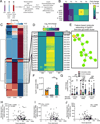Human gut bacterial metabolism drives Th17 activation and colitis
- PMID: 34822777
- PMCID: PMC8785648
- DOI: 10.1016/j.chom.2021.11.001
Human gut bacterial metabolism drives Th17 activation and colitis
Abstract
Bacterial activation of T helper 17 (Th17) cells exacerbates mouse models of autoimmunity, but how human-associated bacteria impact Th17-driven disease remains elusive. We show that human gut Actinobacterium Eggerthella lenta induces intestinal Th17 activation by lifting inhibition of the Th17 transcription factor Rorγt through cell- and antigen-independent mechanisms. E. lenta is enriched in inflammatory bowel disease (IBD) patients and worsens colitis in a Rorc-dependent manner in mice. Th17 activation varies across E. lenta strains, which is attributable to the cardiac glycoside reductase 2 (Cgr2) enzyme. Cgr2 is sufficient to induce interleukin (IL)-17a, a major Th17 cytokine. cgr2+ E. lenta deplete putative steroidal glycosides in pure culture; related compounds are negatively associated with human IBD severity. Finally, leveraging the sensitivity of Cgr2 to dietary arginine, we prevented E. lenta-induced intestinal inflammation in mice. Together, these results support a role for human gut bacterial metabolism in driving Th17-dependent autoimmunity.
Keywords: T helper 17 cells; autoimmune disease; dietary supplementation; human gut microbiome; inflammatory bowel disease; microbial metabolism.
Copyright © 2021 The Author(s). Published by Elsevier Inc. All rights reserved.
Conflict of interest statement
Declaration of interests P.J.T. is on the scientific advisory board for Kaleido, Pendulum, and SNIPRbiome. K.S.P. is on the scientific advisory board of Phylagen. S.V.L. is a co-founder, board member, and consultant for Siolta Therapeutics Inc. This work was partially supported by a MedImmune research grant.
Figures







Comment in
-
Microbial Cgr2 will let your Th17 cells ROR(γT).Cell Host Microbe. 2022 Jan 12;30(1):10-12. doi: 10.1016/j.chom.2021.12.014. Cell Host Microbe. 2022. PMID: 35026131
References
-
- Aletaha D, Neogi T, Silman AJ, Funovits J, Felson DT, Bingham CO 3rd, Birnbaum NS, Burmester GR, Bykerk VP, Cohen MD, et al. (2010). 2010 Rheumatoid arthritis classification criteria: an American College of Rheumatology/European League Against Rheumatism collaborative initiative. Arthritis Rheum. 62, 2569–2581. - PubMed
-
- Almeida A, Nayfach S, Boland M, Strozzi F, Beracochea M, Shi ZJ, Pollard KS, Parks DH, Hugenholtz P, Segata N, et al. (2019). A unified sequence catalogue of over 280,000 genomes obtained from the human gut microbiome. bioRxiv.
MeSH terms
Substances
Supplementary concepts
Grants and funding
LinkOut - more resources
Full Text Sources
Other Literature Sources
Molecular Biology Databases

